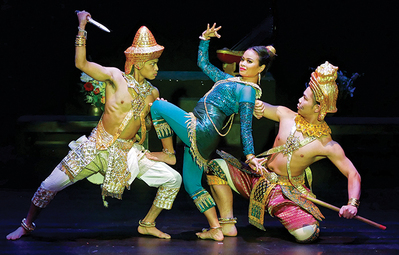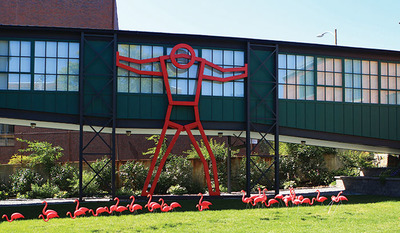Can the Arts Save This Town?

Caleb Neelon, That Was Fun – Let’s Do More mural, 2014, at 564 Main Street, Fitchburg, MA. Image courtesy of Fitchburg Art Museum.
This fall, pink flamingos marched across the lawn of the Fitchburg Art Museum. At first glance, the appearance of these familiar plastic lawn ornaments around Fitchburg seemed to come right out of the playbook of urban theorist Richard Florida, whose 2002 book The Rise of the Creative Class urged cities to make themselves more attractive to the creative types whose innovations—and capital—could revitalize declining post-industrial cities. What better way is there to lure hipsters to an old mill town than with a coolly ironic bit of kitsch? It turns out though, that something more interesting is happening in Fitchburg, and that pink flamingos have a surprising story to tell.
Across New England, small cities are turning to arts tourism and culture industries in search of economic growth. For many towns, the model is MASS MoCA, the Massachusetts Museum of Contemporary Art, which opened in 1999 in a former electronics factory. Aided by its proximity to other tourist infrastructure in southern Vermont and the Berkshires, MASS MoCA is a resounding success as a museum, but whether its rising tide has lifted all the boats in North Adams is less clear. What’s the best long-term plan, especially for small cities that already have cultural institutions as downtown anchors?
That’s a question currently confronting the Fitchburg Art Museum (FAM). Director Nick Capasso and his staff have tapped into the creativity that surrounds them, building on the region’s long history as a blue-collar and immigrant destination. “The story isn’t just about bringing people into the museum,” says Capasso. “It’s about going out into the community.”

Angkor Dance Troupe production of Pin Panhchapor, 2016, in Lowell, MA. Photo: Jonathan Richmond.
This is both a desire and a necessity. FAM averages 15,000 to 16,000 visitors a year, and it doesn’t make sense for them to spend their $1.2 million annual operating budget on so few people, says Capasso. They needed to create more value. Aspects of their curatorial program reflect community interests, and they are involved in areas that art museums don’t usually engage in, such as collaborating on cultural master planning in the city and creating affordable housing for artists.
Across the street from the museum, behind a chain-link fence, sit three abandoned and dilapidated buildings. The museum, in partnership with NewVue Communities, a community development organization in Fitchburg, is converting them into affordable housing for artists. NewVue is responsible for the financing and refurbishing and will retain ownership of the buildings. FAM is the marketing arm—the reason the artists will come. Together they will create live and work two-bedroom apartments, with attached studios for under $1000 a month.
“We’re trying to address conditions that are specific to Fitchburg. This is what we have here and this is what we need now,” says Capasso. “We are not going to become something we’re not, [like] a methadone clinic or a halfway house. We are an art museum, but we try to see everything that we do through the lens of community. It’s not a bunch of programs, it’s an attitude.”
One example is when they commissioned artist Anna Schuleit Haber in the final installation of a three-year National Endowment for the Arts Our Town grant to promote public art that engages the community. In 2015, Haber created her series The Alphabet with the local paper, Sentinel & Enterprise, who gave her the front page every day for 26 days in a row. Each day was devoted to a letter designed by a typographer. The content of the page was keyed to the letter and contained positive stories about Fitchburg written by local students and residents. The regular news stories appeared later in the paper. Good news every day for 26 days on the front page of a newspaper in a struggling city is powerful. It makes people proud of where they live. It gives them hope.

Anna Schuleit Haber, The Alphabet series, 2015, in the Sentinel & Enterprise newspaper. Image courtesy of Fitchburg Art Museum.
Or take Thurston the 18-foot-tall bright red sculpture that graces the outdoor courtyard on Elm Street. The museum commissioned the design from artist Douglas Kornfeld who worked with students at the Montachusett Regional Vocational Technical School to fabricate it. A seventh-grader won the museum’s contest to name the sculpture, calling it Thurston after a metalworker from Fitchburg.
The museum’s signature exhibition this fall, Plastic Imagination, invited artists from all over New England to display works made in this flexible medium. The pink flamingo, it turns out, is local. It was designed by Fitchburg resident Don Featherstone and developed by Union Products in nearby Leominster, MA—the plastics capital of the world. Future programming will also link directly to the history of the community including exhibits inspired by Gardner, MA, known as “the Furniture Capital of New England” and Fitchburg’s own paper industry.
In Fitchburg, as in most of New England’s smaller cities, going out into the community means redefining itself from a “mill town” to a “gateway city” and engaging with new immigrants. “The term ‘gateway cities’ goes back at least to the 1980s,” observes Marilynn Johnson, a history professor at Boston College and author of The New Bostonians: How Immigrants Have Transformed the Metro Area. “Because of gentrification and high housing costs in New York, Boston and other big cities,” she explains, “such towns have increasingly become the landing areas for newly arrived working-class immigrants.” Traveling around New England, the trend is hard to miss: Southeast Asian immigrants in Lowell, MA; Puerto Ricans in Waterbury, CT; Somalis in Lewiston, ME. Fitchburg is home to one of the largest Uruguayan settlements in the United States, thanks to connections between the plastics industries of the two countries. It turns out that the pink flamingo has a South American story as well as a Massachusetts history.

Fitchburg Art Museum courtyard, Flocked with Donald Featherstone flamingo, 2016, in front of Douglas Kornfeld’s Thurston, 2016, epoxy painted steel, 18′ x 17′ x 18″. Photo: Vincent Apollonio.
As gateway cities embrace their new identities, transforming their landmark cultural institutions is crucial. Accessibility is a first step; the Fitchburg Art Museum now labels all its works in both English and Spanish and sometimes offers simultaneous translation to encourage groups to attend events together. Equally important is engagement with ethnic organizations, such as United Neighbors of Fitchburg, with whom FAM created a Uruguayan Film Festival, or the formation of self-consciously multicultural initiatives like the Cultural Organization of Lowell (COOL) in Lowell, MA, whose street festivals and public art projects have brought a burst of color to the city’s downtown.
“Art brings color and vitality to a city,” says Andy Jacobson, president of the board of COOL and owner of Brew’d Awakening Coffeehaus in Lowell. “It brings people to the town and hopefully a mixed business community develops. That traffic helps the local economy.”
Data supporting the economic impact of an art museum or a creative economy is not easy to collect though. It’s hard to quantify quality of place. (In June 2017, however, the Americans for the Arts will release their next national economic impact study, Arts & Economic Prosperity V.)
“People want diversity, they want richness of life…the mystery of life is difficult to do alone,” says Bert Crenca, founder of AS220—an artist-run organization and national model for urban revitalization in Providence, RI, that offers artists opportunities to live, work, exhibit and perform in its many facilities. “There are so many temptations to bury ourselves with a six-pack of beer and Netflix. You want a competitive city? It’s gotta hum. Artists are noisy and that’s good. Look at Bogotá and Medellín—creativity and art and visionary mayors are transforming some of the most complicated places in the world and making phenomenal changes.”
Can states and cities plan for this kind of growth? Most of them are already doing it. In October, Connecticut launched a five-year strategic plan notable for putting diversity and inclusion at the heart of its long-range vision. But there are risks to undertaking the wrong plan. Rebranding a city or neighborhood as an arts tourism destination is easy; because it leverages existing cultural institutions, it requires little investment. But even if it notches up the numbers at museum turnstiles and sends a few more people to downtown restaurants, the city’s overall structure may remain unchanged, and cultural programming may fall behind rapidly changing demographics. Lobbying and tax incentives to lure high-tech “creatives” can grab headlines, but such firms often employ relatively few people, many of them as freelancers or temps in America’s expanding “gig” economy. Rebranding empty lofts as artist condos risks setting off a cycle of gentrification that will push out exactly the diverse populations that have helped gateway cities thrive.

AS220 Youth Mural Crew, George C. Arnold Building in Providence, 2013, mural. Photo: Eric Lubrick.
“Instead of trying to attract yuppies to live in rehabbed mills-turned-condos,” suggests Johnson, local leaders would “do better to focus on mentoring and building educational opportunities for immigrant youth who could potentially provide a homegrown source of entrepreneurial and cultural talent and revitalization.”
Capasso and FAM seem to understand this. “Museums are nonprofits,” he says. “Nonprofits do the work that the electorate has decided they don’t want the government to do, and private corporations see no profit in it. Nonprofits exist to serve people. A lot of art museums are very busy serving art, not people. Going through an exercise of serving art in a city where so many people need help is pointless. So if we can leverage art for the sake of education, community building, economic redevelopment, that’s what we’re going to do. Community and quality are not mutually exclusive.”
Community building—and institutional reinvention—are slow processes that may not yield results for a generation. But it’s worth remembering that the tortoise did beat the hare in the end. Perhaps the pink flamingo and the Fitchburg Art Museum will too.
Christopher Capozzola is an associate professor of history at the Massachusetts Institute of Technology. Sarah Baker is a contributing editor of Art New England.
